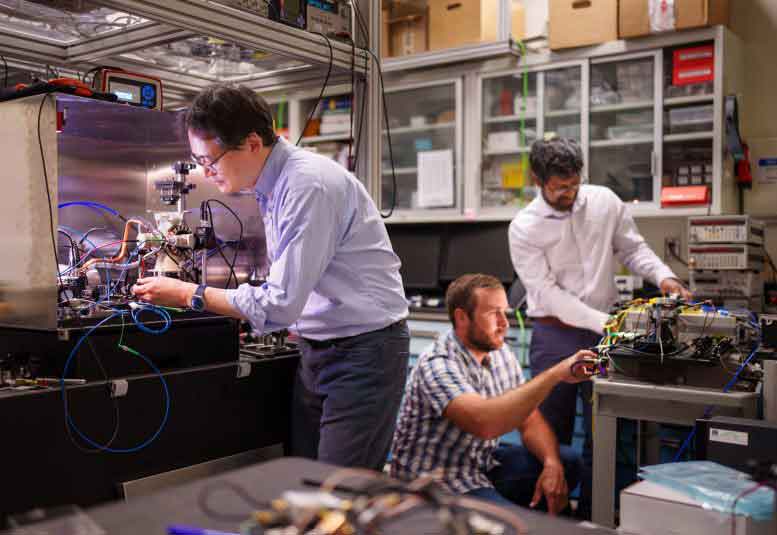Unlocking the Future: The Revolutionary Quantum Compass That Makes GPS Obsolete!
revolutionary quantum compass GPS free
Revolutionary Quantum Compass: The Future of GPS-Free Navigation
A groundbreaking advancement in quantum sensing is on the horizon, heralding the advent of GPS-independent navigation with remarkable precision.
Within the confines of devices like smartphones, fitness trackers, and virtual reality headsets lies a diminutive motion sensor that meticulously monitors position and movement.
Larger, more sophisticated counterparts—comparable in size to a grapefruit and boasting a thousand-fold increase in accuracy—serve as navigational aids for ships, airplanes, and other vehicles, complementing GPS technology.
Now, scientists are on the cusp of crafting a motion sensor of such precision that it could substantially diminish national dependence on global positioning satellites.
Not long ago, such a sensor—capable of achieving sensitivity a thousand times greater than current navigation-grade devices—would have occupied an entire moving truck.
However, recent innovations are dramatically reducing both the size and cost of this technology.
For the first time, researchers at Sandia National Laboratories have successfully employed silicon photonic microchip components to execute a quantum sensing technique known as atom interferometry—an exceptionally precise method for measuring acceleration.
This represents a significant stride toward developing a quantum compass, essential for navigation in the absence of GPS signals.
The team has published their findings, introducing a novel high-performance silicon photonic modulator—a device that manipulates light on a microchip—as the cover story in Science Advances.
This research was backed by Sandia’s Laboratory Directed Research and Development program, conducted in part at the National Security Photonics Center, a collaborative hub focused on integrated photonics solutions for complex national security challenges.
GPS-independent Navigation: A National Security Imperative
“Accurate navigation becomes problematic in real-world scenarios where GPS signals are unavailable,” stated Sandia scientist Jongmin Lee. In conflict zones, this issue escalates into a national security threat, as electronic warfare units can jam or deceive satellite signals, disrupting military operations and troop movements.

Quantum sensing provides a potential solution.
“By leveraging the principles of quantum mechanics, these advanced sensors offer unparalleled precision in measuring acceleration and angular velocity, ensuring accurate navigation even in GPS-denied environments,” Lee explained.
Modulator: The Heart of a Chip-Scale Laser System
Typically, an atom interferometer occupies an entire room. A complete quantum compass—more accurately termed a quantum inertial measurement unit—would necessitate six such interferometers.
However, Lee and his team are pioneering methods to reduce the system’s size, weight, and power requirements.
They have already replaced a bulky, energy-intensive vacuum pump with a compact, avocado-sized vacuum chamber and consolidated several components traditionally spread across an optical table into a single, robust apparatus.
The new modulator is the linchpin of a laser system on a microchip. Designed to withstand heavy vibrations, it replaces the conventional laser systems that are often the size of refrigerators.
Lasers perform multiple functions in an atom interferometer, and the Sandia team employs four modulators to shift the frequency of a single laser for various tasks. However, modulators can generate unwanted echoes known as sidebands, which require mitigation.
Sandia’s suppressed-carrier, single-sideband modulator significantly reduces these sidebands by an unprecedented 47.8 decibels—a measure traditionally used for sound intensity, but equally applicable to light intensity—resulting in a nearly 100,000-fold decrease.
“We’ve drastically enhanced performance compared to existing technologies,” said Sandia scientist Ashok Kodigala.
revolutionary quantum compass GPS free: Silicon Devices: Scalable and Economical
In addition to size, cost has been a major barrier to deploying quantum navigation systems. Each atom interferometer demands a laser system, and laser systems require modulators.
“A full-size, single-sideband modulator commercially available today costs over $10,000,” Lee noted.
By miniaturizing large, expensive components into silicon photonic chips, costs can be significantly reduced.
“We can fabricate hundreds of modulators on a single 8-inch wafer, and even more on a 12-inch wafer,” Kodigala pointed out.
Because they can be produced using the same processes as virtually all computer chips, “This sophisticated four-channel component, complete with additional custom features, can be mass-produced at a fraction of the cost of current commercial alternatives, paving the way for more affordable quantum inertial measurement units,” Lee said.
As this technology nears field deployment, the team is investigating other applications beyond navigation. Researchers are exploring whether it could detect subterranean cavities and resources by sensing the subtle gravitational changes they cause. There is also potential for the optical components they have developed, including the modulator, in fields such as LIDAR, quantum computing, and optical communications.
“I find it incredibly exciting,” Kodigala remarked. “We’re making substantial progress in miniaturization for various applications.”
Multidisciplinary Collaboration Bringing Quantum Compass to Reality: revolutionary quantum compass GPS free
Lee and Kodigala represent two facets of a multidisciplinary team. Lee’s half comprises experts in quantum mechanics and atomic physics, while Kodigala’s half specializes in silicon photonics—imagine a microchip where light, rather than electricity, navigates its circuits.
These teams collaborate at Sandia’s Microsystems Engineering, Science, and Applications complex, where researchers design, produce, and test chips for national security purposes.
“We have colleagues just down the hall that we can consult with to solve key challenges, accelerating the path of this technology from the lab to the field,” said Peter Schwindt, a quantum sensing scientist at Sandia.
The team’s overarching objective—to transform atom interferometers into a compact quantum compass—bridges the divide between fundamental research at academic institutions and commercial development within the tech industry.
Atom interferometers are a proven technology with immense potential for GPS-independent navigation. Sandia’s ongoing efforts aim to make these systems more stable, field-ready, and commercially viable.
The National Security Photonics Center collaborates with industry, small businesses, academia, and government agencies to pioneer new technologies and bring new products to market. Sandia boasts hundreds of issued patents, with many more in the pipeline, all supporting its mission.
“I’m passionate about seeing these technologies transition into practical applications,” Schwindt said.
Michael Gehl, a Sandia scientist specializing in silicon photonics, shares this enthusiasm. “It’s rewarding to see our photonics chips being applied in real-world scenarios,” he said.
Reference
“High-performance silicon photonic single-sideband modulators for cold-atom interferometry” by Ashok Kodigala, Michael Gehl, Gregory W. Hoth, Jongmin Lee, Christopher T. DeRose, Andrew Pomerene, Christina Dallo, Douglas Trotter, Andrew L. Starbuck, Grant Biedermann, Peter D. D. Schwindt, and Anthony L. Lentine, 10 July 2024, Science Advances.
revolutionary quantum compass GPS free







